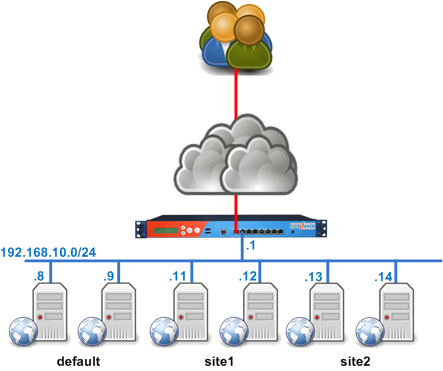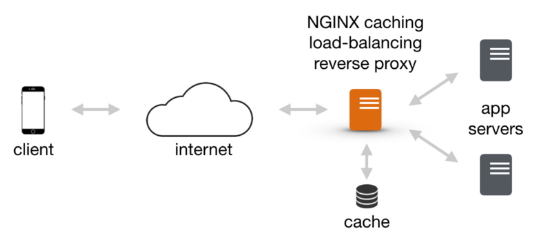May 08, 2018 ProxyPass /static! States that we don’t proxy any request beginning with the keyword /static/ (you need to state their the name of your folder for content).The rest of the requests are going to be proxied to our application, deployed on Tomcat (the path to the application is defined by ProxyPass and ProxyPassReverse). This tutorial will show you how to configure Tomcat Load Balancing with Apache webserver (http server) using Mod Proxy. I have listed here the following steps on how to configure Apache with Tomcat to configure Load Balancer using Mod Proxy. Mar 18, 2017 A common setup for Java web applications is to run Tomcat behind a web server like Apache in a reverse proxy configuration. This allows Apache to handle all incoming and outgoing traffic between. About Sample Values and Copying of Text. Example.com is used as a sample domain name (in key names and configuration blocks). Replace it with your organization’s name. Many NGINX Open Source and NGINX Plus configuration blocks in this guide list two sample Tomcat application servers with IP addresses 10.100.100.11 and 10.100.100.12. Replace these addresses with the IP addresses of your. No, Tomcat won't automatically use the system proxy settings. I suggest you look into the facilities provided by java.net.Proxy. This allows you to dynamically specifiy a proxy at runtime.
Proxy Support HOW-TO
Table of Contents
Introduction
Using standard configurations of Tomcat, web applications can ask for the server name and port number to which the request was directed for processing. When Tomcat is running standalone with the HTTP/1.1 Connector, it will generally report the server name specified in the request, and the port number on which the Connector is listening. The servlet API calls of interest, for this purpose, are:
ServletRequest.getServerName(): Returns the host name of the server to which the request was sent.ServletRequest.getServerPort(): Returns the port number of the server to which the request was sent.ServletRequest.getLocalName(): Returns the host name of the Internet Protocol (IP) interface on which the request was received.ServletRequest.getLocalPort(): Returns the Internet Protocol (IP) port number of the interface on which the request was received.
When you are running behind a proxy server (or a web server that is configured to behave like a proxy server), you will sometimes prefer to manage the values returned by these calls. In particular, you will generally want the port number to reflect that specified in the original request, not the one on which the Connector itself is listening. You can use the proxyName and proxyPort attributes on the <Connector> element to configure these values.
Proxy support can take many forms. The following sections describe proxy configurations for several common cases.
Apache 1.3 Proxy Support
Apache 1.3 supports an optional module (mod_proxy) that configures the web server to act as a proxy server. This can be used to forward requests for a particular web application to a Tomcat instance, without having to configure a web connector such as mod_jk. To accomplish this, you need to perform the following tasks:
Configure your copy of Apache so that it includes the
mod_proxymodule. If you are building from source, the easiest way to do this is to include the--enable-module=proxydirective on the./configurecommand line.If not already added for you, make sure that you are loading the
mod_proxymodule at Apache startup time, by using the following directives in yourhttpd.conffile:Include two directives in your
httpd.conffile for each web application that you wish to forward to Tomcat. For example, to forward an application at context path/myapp:which tells Apache to forward URLs of the form
http://localhost/myapp/*to the Tomcat connector listening on port 8081.Configure your copy of Tomcat to include a special
<Connector>element, with appropriate proxy settings, for example:which will cause servlets inside this web application to think that all proxied requests were directed to
www.mycompany.comon port 80.It is legal to omit the
proxyNameattribute from the<Connector>element. If you do so, the value returned byrequest.getServerName()will by the host name on which Tomcat is running. In the example above, it would belocalhost.If you also have a
<Connector>listening on port 8080 (nested within the same Service element), the requests to either port will share the same set of virtual hosts and web applications.You might wish to use the IP filtering features of your operating system to restrict connections to port 8081 (in this example) to be allowed only from the server that is running Apache.
Alternatively, you can set up a series of web applications that are only available via proxying, as follows:
- Configure another
<Service>that contains only a<Connector>for the proxy port. - Configure appropriate Engine, Host, and Context elements for the virtual hosts and web applications accessible via proxying.
- Optionally, protect port 8081 with IP filters as described earlier.
- Configure another
When requests are proxied by Apache, the web server will be recording these requests in its access log. Therefore, you will generally want to disable any access logging performed by Tomcat itself.
When requests are proxied in this manner, all requests for the configured web applications will be processed by Tomcat (including requests for static content). You can improve performance by using the mod_jk web connector instead of mod_proxy. mod_jk can be configured so that the web server serves static content that is not processed by filters or security constraints defined within the web application's deployment descriptor (/WEB-INF/web.xml).
Apache 2.0 Proxy Support
AddModule mod_proxy.c) Notice: This comments section collects your suggestions on improving documentation for Apache Tomcat.
If you have trouble and need help, read Find Help page and ask your question on the tomcat-users mailing list. Do not ask such questions here. This is not a Q&A section.
The Apache Comments System is explained here. Comments may be removed by our moderators if they are either implemented or considered invalid/off-topic.
npm install axiospackage.json. Check version of react-scripts.package.json itself using proxy property. changeOrigin is used if domains are different. Otherwise you might get a CORS error. Finally, You can add all your headers, if any, under headers property.proxy property option, we can now also move all proxy configurations into a separate file named setupProxy.js. Note that although proxy property works, it can accept only a string. If its an object use setupProxy.js instead. To recognize this file, we need to install an npm module as :npm install http-proxy-middleware
setupProxy.js in src folder and add your proxy configurations in it.headers property or using a function called on the event onProxyReq.This is all about Development configuration. Now lets look at Production configuration. Before that, lets create a production build using,npm run buildTomcat Proxyport

1. Enable the following modules in httpd.conf :
LoadModule proxy_module modules/mod_proxy.soLoadModule proxy_http_module modules/mod_proxy_http.soLoadModule ssl_module modules/mod_ssl.so - If not already enabledLoadModule rewrite_module modules/mod_rewrite.so2. Add the following configuration in httpd.conf file
 React Router Configuration - Apache Http Server, Nginx, Tomcat
React Router Configuration - Apache Http Server, Nginx, Tomcat/react-proxy-config and make sure you are seeing the data from your API.1. Add the following in nginx.conf :
Tomcat Http Proxy Download
webapps folder of tomcat and add the below configuration in Apache httpd.conf file.http://localhost/react-proxy-config/Tomcat Http Proxy Server
